Our friend's mispronunciation of the legendary German tuner brand is rather surprising. He had just climbed from an Isuzu Vehicross, so he's obviously a connoisseur of important automobiles (well, rare ones anyway). But our 2007 BMW Alpina B7 had thrown him a backdoor curveball."
At first I didn't know what to make of it," he says. "But then I saw that Alpina badge and I knew it was something special."
B7 Not M7
It is something special. Packing a supercharger and 21-inch wheels and tires, the ultrahigh-performance BMW Alpina B7 is unlike any other BMW, including those developed by BMW M, the company's own in-house speed shop.
"It's sort of a limited-edition, factory-approved, tuner version of the 750i," we tell our friend. "BMW builds a 750i in its factory in Dingolfing, Germany, then ships it to Alpina's facility up the road in Buchloe, where it becomes a B7."
"So it's sorta like one of them Sayleen Mustangs," he says with remarkable insight. "Only German and way more expensive."
He's right. Saleen modifies Ford Mustangs for a living, but the United States government considers it a small manufacturer, and Alpina has the same status over in Deutschland.
"Yeah, kind of," we reply, "but you better make that way, way more expensive."The BMW Alpina B7 carries a base price of $115,695 and includes the interior and all the standard features of a 760Li including power sunshades and soft-close doors. But there are extra-cost options, and our test car has them all, including night vision and a rear-seat entertainment system. Toss in the $1,300 gas-guzzler tax and the B7's MSRP is a knee-buckling $124,480. Or approximately three Saleens.
"Wow," says our admirer. "Have you ever driven an Austin Martin or a Lamborghini Gayyardo?"
Alpina, the Story
You can't really blame our friend for his lack of exposure to Alpina. Although the tuner has been tweaking BMWs since 1961, the B7 is only the second Alpina-modified BMW ever offered in America. The first was the Roadster V8, a car based on the Z8 Roadster, and BMW imported only 450 of them in 2002-'03.
Alpina first made its name when it helped BMW develop the lightweight BMW 3.0 CS of the early 1970s, but the company's recent models have delivered very high levels of performance at moderate engine rpm and with an automatic transmission.
In other words, they contrast starkly with the machines developed by BMW M, which always feature high-revving engines backed by either a manual or sequential manual (SMG) transmissions.With the appearance of an AMG version of the new Mercedes-Benz S-Class, BMW has decided it needs a breathed-on 7 Series to keep pace, but an M7 has never been part of the company's portfolio and possibly never will. "For an ultraperformance version of the 7 Series, a platform that is defined by lavish luxury and generous interior space and offered only with an automatic transmission, something other than 'M' performance character was called for," BMW tells us.
Enter the boys from Buchloe and the blower. Bolt on the Blower
Bolt on the Blower
The blower is a centrifugal supercharger bolted to the front of the B7's DOHC 4.4-liter V8. Although BMW fits its 750i with a 360-horsepower 4.8-liter V8, Alpina uses the smaller-displacement V8 used in this car's predecessor, the 745i. Alpina has also fortified the engine with a stronger bottom end, a lower 9.0:1 compression ratio and a new exhaust system.
The supercharger makes 12.0 psi of boost, which cranks up the engine's power peaks to 500 hp at 5,500 rpm and 516 pound-feet of torque at 4,250 rpm. That's up from 325 hp and 330 lb-ft of torque, so you should be considerably impressed. It's also 62 hp more than you get in the V12-powered 760Li.
Throttle response is a bit sluggish (probably due to that long intake tract), but all that grunt (along with the shorter final-drive ratio from the 760Li) is enough to make this the quickest 7 Series you can buy. Acceleration to 60 mph is accomplished in a neck-snapping 5.0 seconds flat, and the quarter-mile is covered in only 13.3 seconds at more than 108 mph. Wicked quick in anybody's book, and more than a second quicker to 60 mph than the last 750i we tested.
Sure, an M5 will eat its lunch in the quarter-mile, but the B7 nearly matches the M5's 0-60-mph run of 4.8 seconds. It's a real testament to the B7's serious bottom-end torque, especially when you realize the B7 weighs 4,704 pounds — 700 more than an M5.
So the blower works, but it does its thing incognito. Blower whine is not part of the B7's soundtrack. Instead, its big V8 supplies its endless amounts of torque with a deep V8 bellow — again in stark contrast to the high-pitched exhaust sound of an M engine.
Backing the beast is the same six-speed automatic used in a 750i, but Alpina has fitted it with Switch-Tronic, a manual-shift program controlled by buttons located on the back of the Alpina steering wheel. The buttons work well enough, but the B7's transmission is not this car's finest piece. Aside from the fact that it makes every start from a stop in 2nd gear, we find it annoying that the transmission doesn't hold gears in manual mode nor does it match revs when downshifted. If the B7's engine might be ranked a 9.5, its transmission is just a 5. Ridin' in Style
Ridin' in Style
Alpina does, however, get the B7's suspension just right. The combination of firmer suspension calibration and 21-inch wheels and tires sounds like a recipe for a teeth-chattering ride. But it isn't. The B7's ride is certainly on the firm side of the luxury sedan envelope, but it's remarkably smooth and compliant.
By the way, the design of these 21-inch radial-spoke rims is an Alpina signature. It features 20 slender spokes and mimics a design Alpina has used on every one of its models since the BMW 3.0 CS of the early '70s. And those 21-inch Michelins, well, they cost $550 apiece to replace. How do we know? Don't worry about it. Just keep the B7's stability control on or be ready to write a large check to your local tire shop.
Although the wheels are what everyone notices first about the B7, the sizable rear spoiler and the other tweaks to the look of this 7 Series don't exactly go unnoticed. Meanwhile, the interior additions are more subtle. Along with the three-spoke steering wheel, Alpina adds only badging and a new instrument cluster with a 200-mph speedometer.
Steering feel is exceptional and the factory-installed Active Roll Stabilization system keeps body roll in check. The B7's balance and overall grip is impressive. This very large, very heavy sedan generated 0.85g on our skid pad and blazed through our slalom at almost 69 mph. In other words, it handles as well as an M5, but with a much more agreeable ride.
The B7 also stops like an M5, hauling down from 60 mph in just 114 feet with absolutely zero fade after three hard stops. Again, this car weighs 4,704 pounds. Unbelievable. Alpina has accomplished this by fitting the brakes from the 760i — a model only sold in European markets — that feature rotors that are 1 inch larger in diameter.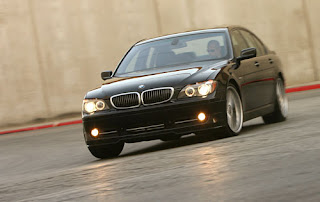 It's a Hit
It's a Hit
BMW calling in Alpina on this one is like a scene from The Sopranos. Remember when Tony tells Silvio to call in "some friends of ours from out of state?" You know, to take care of the thing with the guy. Why get the dirt under your own fingernails?
Did Alpina make the hit? Fahgeddaboudit, the 2007 BMW Alpina B7 is one of the finest and fastest sedans ever. It's just what the doctor (make that the Beverly Hills plastic surgeon) ordered to help BMW fight off the S63s and S8s of the world.If you buy one, just be prepared to educate the Vehicross contingent.
2007 BMW Alpina B7
Full Test: 2007 FPV Ford Falcon GT A Four-Door Mustang From Down Under
We Aussies find it amusing that our most American-inspired cars turn out to be so inspiring to Americans. As you've heard, General Motors is plugging a gap in its performance credibility with the Australian-built Holden Commodore SS, which will become the 2008 Pontiac G8.
It seems to us that the 2007 Ford Falcon GT would be a good choice for you Yanks as well. Ford's Interceptor Concept from the 2007 Detroit Auto Show and its 427 concept from the 2003 Detroit show suggest Dearborn also has a hankering for a full-size, rear-wheel-drive, high-performance sedan, and the Ford Falcon here in Australia is the most obvious candidate.
The large, rear-drive V8-powered sedan took root here in the Antipodes exactly 40 years ago, when Ford Australia introduced its Mustang-bred Falcon XR GT 289. Since then, an environment of sunshine, beer and barbecues has made the Falcon the kind of car that should be sold in America.
And You Thought NASCAR Came From the Deep South
Ford might squander the credibility of its nameplates in other countries, but the "Falcon GT" moniker has never been used lightly at Ford Australia. The seminal 1967 Falcon XR GT went right into competition once it was launched and finished 1st and 2nd in the annual Bathurst 500-mile touring car race. The victory prompted Holden to fight back with its first Monaro, using an imported Chevrolet 327-cid V8 in its Bathurst racer.
Epic battles between the Falcon and Monaro ensued through the 1970s, until Ford Australia unwisely dropped its V8 option from the Falcon range in November 1982. It was 10 years before the Ford V8 (known as the "blue bent-eight" by the locals) came back into production, losing a whole generation of Ford buyers to performance-minded Holden.
So influential and fondly remembered is the original Falcon GT that a low-mileage yet historically unremarkable example of the 1971 XY Falcon GTHO Phase 3 — in its day, the world's fastest four-door — sold at auction for a record U.S. $567,293. Makes you wonder what the Falcon driven by Max Rockatansky (you know, Mad Max) would fetch.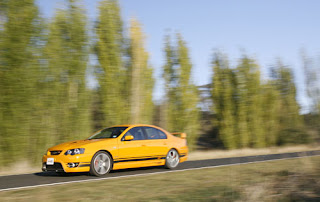 The Flight of the Falcon
The Flight of the Falcon
As with the Holden Commodore, these days the Ford Falcon does most of its business as a six-cylinder fleet-and-family car. In fact, V8 variants constitute roughly 15 percent of each car's sales. Holden uses the 6.0-liter pushrod LS2 imported for this purpose, while Ford has a locally assembled 5.4-liter SOHC unit.
Your Falcon enthusiast can choose among a 310-horsepower 24-valve SOHC V8, 350-hp 32-valve DOHC performance Falcon XR8 or a turbocharged 330-hp inline-6 XR6 Turbo.
And then there are the image-making, limited-edition Falcons from factory-owned hot-rod shops like Ford Performance Vehicles (FPV). Back in 2003, FPV partnered with ProDrive (the English motorsports engineering specialist) and finally got Ford's performance-brand image together. Today the collaboration supplies FPV with a range of sedans powered by either a 362-hp version of the turbocharged inline-6 or a 389-hp DOHC V8.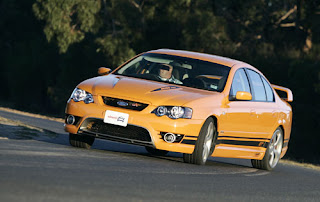 Emotional Engineering
Emotional Engineering
Named for its output in kilowatts, the "Boss 290" engine in our bright-orange FPV Ford Falcon GT test car is a transpacific freak. The 5.4-liter V8 uses a Mustang Cobra R block and 32-valve DOHC cylinder heads from America, while the pistons, bearings, inlet manifold and exhaust headers are sourced in Australia.
FPV maintains that it doesn't want to get involved in a horsepower war with Holden Specialty Vehicles (HSV), which is an elegant way of conceding defeat before you've even left the showroom. While FPV's slogan of "total performance" applies to the well-integrated package of accessories worn by this Falcon GT, the hardware isn't especially exciting.
There's the engine, for instance. With not much happening underfoot until the tachometer needle swings past 3,500 rpm, you're thinking this quad-cam V8 must be a screamer. But no sooner has the V8 begun to come alive than it gets breathless beyond 5,500 rpm and finally splatters against the rev limiter at 6,000 rpm.
There's no alternative but to dip the long-throw clutch pedal again and have a grumble through the knuckly gate of the six-speed manual transmission. The first four cogs are nicely useful, but the direct-drive 5th and overdrive 6th leave the V8 snoozing at the 70-mph speed limit ruthlessly enforced on Australian freeways.
With a 0-60-mph time of 5.7 seconds and a quarter-mile run of 14.5 seconds at 98.9 mph, the Falcon GT is slower than the Holden Commodore SS, which itself gets to 60 mph in 5.3 seconds on its way to the quarter-mile in 14.1 seconds at 99.1 mph. You've Mellowed These Last 40 Years
You've Mellowed These Last 40 Years
In many ways, however, the Falcon GT is admirably swift and competently composed.
Most remarkable is the ride quality, as it's very comfortable across all but the most patchy surfaces, where the body control begins to suffer from the combination of limited suspension travel and soft rebound damping. It's a useful achievement considering the car's aggressive 245/35R19 tires.
In GT trim, the Falcon's double-wishbone front suspension and independent multilink rear suspension get a lower ride height with unique springs, dampers and antiroll bar. But the Falcon's curb weight of 4,090 pounds sabotages the car's handling at the limit. One also has to remember that this is a big car: just a fraction of an inch shorter than the .
We managed a slalom run of 64.9 mph and then recorded 0.84g around the skid pad. The Ford is agile enough to be entertaining, but not swift enough to keep up with the Holden's 67.6-mph slalom speed and its 0.87g skid pad performance.
The Falcon's steering isn't fazed much by road undulations and its turn-in is consistent and quick, but the thick-rimmed steering wheel transmits more hydraulic effort than road feel. The seats feel good, though the support is compromised by the need to accommodate our big, beefy Aussie frames.
We Don't Slow Down Much in Australia
Even these bold, baboon-butt Brembo brakes don't deliver fully on their promise. While pedal modulation feels great, the Falcon GT came to a stop from 60 mph in 122 feet, 5 feet longer than the stop recorded by the Holden Commodore SS we tested on the same day. It seems like a disappointing performance from such an expensive brake package with six-piston front calipers and four-piston rears.
Slightly oversensitive calibration of the ABS also flusters braking performance over road ripples, making apex-picking a challenge during press-on, open-road punting.
Well, all of that's true in Australia, anyway. Our roads vary from divided highways to wandering tracks across the Outback, so it's easy to turn up the compromises that must be built into a platform that must be sufficiently tough for daily dirt-road use, yet sophisticated enough to aspire to the performance of a European sport sedan.
You know what it is? The Falcon GT's shortcomings are the things that make it feel to Australian drivers as if it's a bit, well, American.
Winging Its Way to Where?
The Aussie Falcon's future has been debated for about as long as Dearborn has lacked a decent platform for a large rear-drive sedan.
It seems that each new generation of the Falcon is predicted to be its last, as smaller international platforms (like the DEW98 platform beneath the current Ford Mustang and Jaguar S-Type) are constantly tipped to replace this Aussie-engineered production, which is as old as grandfather's axe.
Next to the VE Commodore, however, the Falcon does feel a generation older. That's why a substantial revision of the Falcon platform is due next year, we're told. Apparently Ford will address the Falcon's dull feel from the front tires with a stronger front subframe, new lower wishbones for the front suspension and a new steering system.
Almost certainly, however, this new car will be the last unique, all-Aussie Falcon. The next-generation platform, due around 2012, will be shared with Ford's rear-drive U.S. models. If we're lucky, Dearborn will have learned a few things from the Aussies by then.
[sourcing: http://www.edmunds.com/]
2008 Porsche Cayenne S
Just over a half-decade old, the Porsche Cayenne provides a valuable real-world lesson about the business of building automobiles: a couple of lessons in fact.
First and foremost, the 2002 debut of the V8-powered Porsche SUV proved you could teach an old dog new tricks: the perennial sports car builder pulled off the improbable to design and produce a crackerjack luxury sport SUV right out of the gate.
Though a little late to that category, the Cayenne quickly caught the attention of the well-heeled looking for a little five-seater excitement, and by 2005 - just three years into production - the SUV became Porsche’s top selling model in North America with more than 100,000 units sold.
Even Porsche traditionalists, who were initially convinced Dr. Ferry Porsche was spinning in his grave at the very notion of a Porsche ‘truck,’ grudgingly grew to accept the Cayenne - though more for the fact its robust sales figures dramatically improved Porsche AG’s financial forecast - which meant the company would be making two-seaters well into the 21st Century (an outlook in the late-1990s that appeared unlikely).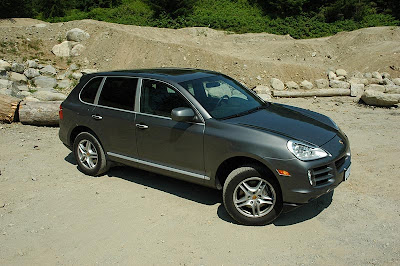 A second lesson gleaned from the Cayenne’s quick ascendancy is that the number of baby boomers willing to pay big dollars for a five-door fitted with an eight-cylinder Porsche engine thirstier than a tableful of mechanics on holiday in Bavaria, is limited.
A second lesson gleaned from the Cayenne’s quick ascendancy is that the number of baby boomers willing to pay big dollars for a five-door fitted with an eight-cylinder Porsche engine thirstier than a tableful of mechanics on holiday in Bavaria, is limited.
Porsche North America sold 13,607 Cayennes in 2005 (roughly 5,000 base models, 6,000 S models and 2,500 Turbos), easily outpacing Boxster and 911 sales. But that changed in 2006, as 911 sales ballooned to just over 12,000, combined Boxster and Cayman sales passed 11,500 and Cayenne numbers fell to 10,569.
Higher North American fuel prices, new sexy models from other luxury car builders and a slowing economy all contributed to slipping Cayenne sales.
Which begs the question: will 2005 be the high-water mark of the Porsche Cayenne? Or will the second-generation Cayenne, the 2008, get those boomers back in Porsche dealerships with chequebooks in hand?
Early indications for the 2008 model are promising, as Cayenne sales in North America for June were up 57 per cent over the previous year, while in Canada the improvement was 61 per cent.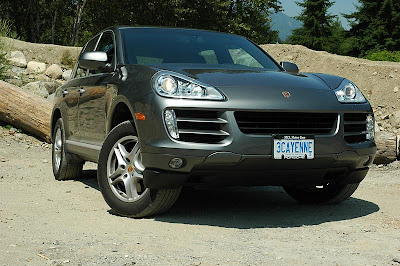 The final lesson here is one not yet formed, as the days are still early for the 2008 Cayenne.
The final lesson here is one not yet formed, as the days are still early for the 2008 Cayenne.
But with rumblings that Porsche is developing a smaller SUV model, called the Roxster, the long-term fate of the Cayenne hangs in the balance, with much of it dependent on the success of the ’08 Cayenne and possibly the rumoured-to-be-coming Cayenne Hybrid.
So, what have the brilliant engineering and design minds of Porsche done to improve their SUV? Not surprisingly, more muscle, both inside and out.
The first thing that strikes you about the 2008 Cayenne S is its striking snout. With headlight arrays like futuristic dragon’s eyes, a sensuously bulging hood subtly hinting at the power that lurks beneath, and muscular wheel arches, there is little doubt this beast is all Porsche all the time. As with the first generation, though, the aggressive and well-sculpted front end doesn’t flow through the rest of the body. Indeed, from some rear angles, the Cayenne looks as pedestrian a SUV as is out there (okay, minus the bad-ass, stainless steel exhaust pipes poking out from underneath).
As with the first generation, though, the aggressive and well-sculpted front end doesn’t flow through the rest of the body. Indeed, from some rear angles, the Cayenne looks as pedestrian a SUV as is out there (okay, minus the bad-ass, stainless steel exhaust pipes poking out from underneath).
Badass is the best way to describe the new V8 engines that power the three 2008 Cayenne models available in Canada. The base comes with a 290-hp, 3.6-litre engine with a reported 0-96 km/h time of 7.5 seconds; the S with a 385-hp, 4.8-litre clocked at 6.4 seconds; and the Turbo with a couple of turbochargers that boost the 4.8 litre’s horsepower to a monstrous 500 with a zero-to-96 km/h (60 mph) time of a mere 4.9 seconds. (For comparison’s sake, the 2008 911 Turbo Cabrio is said to achieve this from a standing stop in just 3.7 seconds). I guess the Cayenne Turbo is for the perennially late soccer mom.
All three engines utilize direct fuel injection, a first for the Cayenne, and all three objectives of the new fuel delivery system - reduced emissions, improved fuel consumption and increased power - have been achieved, though I’ll leave it to the reader to determine if a city L/100km rating of 16.3 (17 mpg) can fairly be called an ‘improvement.’ Still, Porsche’s claim of a 15 per cent improvement in the S and 11 per cent in the Turbo is definitely moving in the right direction. Like all guilty pleasures, hammering the Cayenne S on an open stretch of highway with the Sport button engaged puts all thoughts of saving the planet out of your mind, or at least until the next off-ramp. Sport button? Simply press the non-descript and oddly large button located below the gear shift on the centre console and engine output increases thanks to some high-falutin’ computer chip mapping. Make sure you’ve got both hands on the heated and leather-wrapped steering wheel though as the noticeable power surge can catch a driver unaware. This may be an SUV, but it also has a highly tuned Porsche power plant delivering plenty of pull throughout its power band.
Still, Porsche’s claim of a 15 per cent improvement in the S and 11 per cent in the Turbo is definitely moving in the right direction. Like all guilty pleasures, hammering the Cayenne S on an open stretch of highway with the Sport button engaged puts all thoughts of saving the planet out of your mind, or at least until the next off-ramp. Sport button? Simply press the non-descript and oddly large button located below the gear shift on the centre console and engine output increases thanks to some high-falutin’ computer chip mapping. Make sure you’ve got both hands on the heated and leather-wrapped steering wheel though as the noticeable power surge can catch a driver unaware. This may be an SUV, but it also has a highly tuned Porsche power plant delivering plenty of pull throughout its power band.
In addition to the more powerful engines, the biggest technological achievement on the second generation Cayenne is something called Porsche Dynamic Chassis Control, an ingenious system that controls and regulates the air suspension system (standard on the Turbo and optional on the base and S models).
Not only does the chassis control system significantly decrease body roll through tight corners (or for that matter, long sweepers) over the first generation Cayenne, it makes steering crisper and braking smoother. The reason Cayennes haven’t been wrapping themselves around telephone standards like those tail-happy Porsche Turbos of lore is simply stunning driving dynamics.
The dual-range all-wheel drive system is arguably one of the best in the business in this sort of application, and if you’ve got the nerve and bank manager’s blessing for it, an off-road excursion on some of Canada’s toughest logging roads is well within reason. Just make sure you swap off the low-profile speed rated Michelins for a meatier set of boots. Getting the new Cayenne a little dirty was obviously on the mind of cabin designers, as a rubberized and high-sided cargo floor is easy to wipe down with soap and water.
As to interior changes, the second generation is crammed full of all the typical luxury class cabin creature comforts. From 12-way adjustable heated leather front seats to a 14-speaker Bose sound system, and from a multifunctional steering wheel with gear shift buttons to an integrated carbon filter for the cabin’s environment, the 2008 Cayenne is what you’d expect from an SUV with a sticker price north of $75,000.
When it all comes down to it, it will be that sticker price that really determines the fate of the second-generation Cayenne and any new generations to come. It remains to be seen how many wealthy people still covet an SUV with the soul of a sports car.
BBC motoring guru Jeremy Clarkson summed this sentiment up well when he quipped about the original Cayenne, “just as no-alcohol lager defeats the objective, so does a Porsche off-roader.”
It turned out old Jeremy was a little off the mark there, as North American sales hit record proportions and the motoring public fell in love with the first generation Cayenne. The second generation does what is hoped of all offspring and betters its lineage in both power and performance.
Only time will tell if it can improve on the lofty sales figures its near ancestor set.